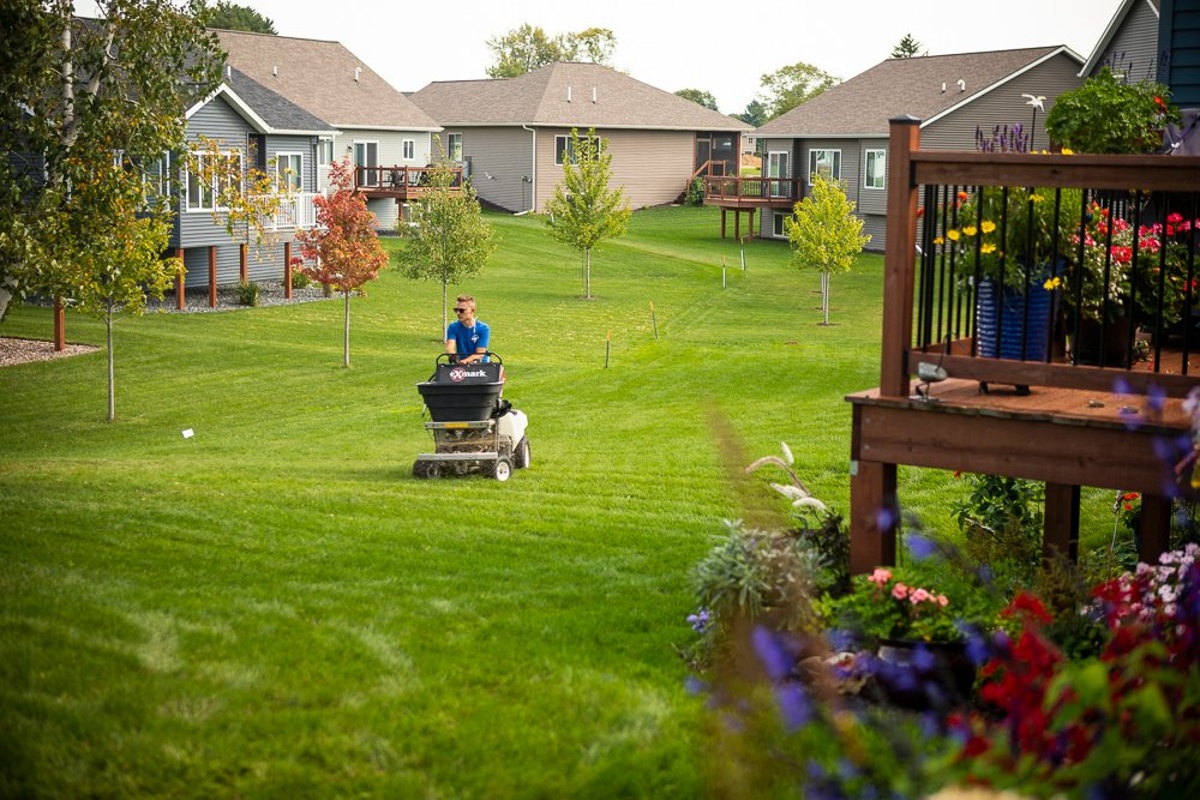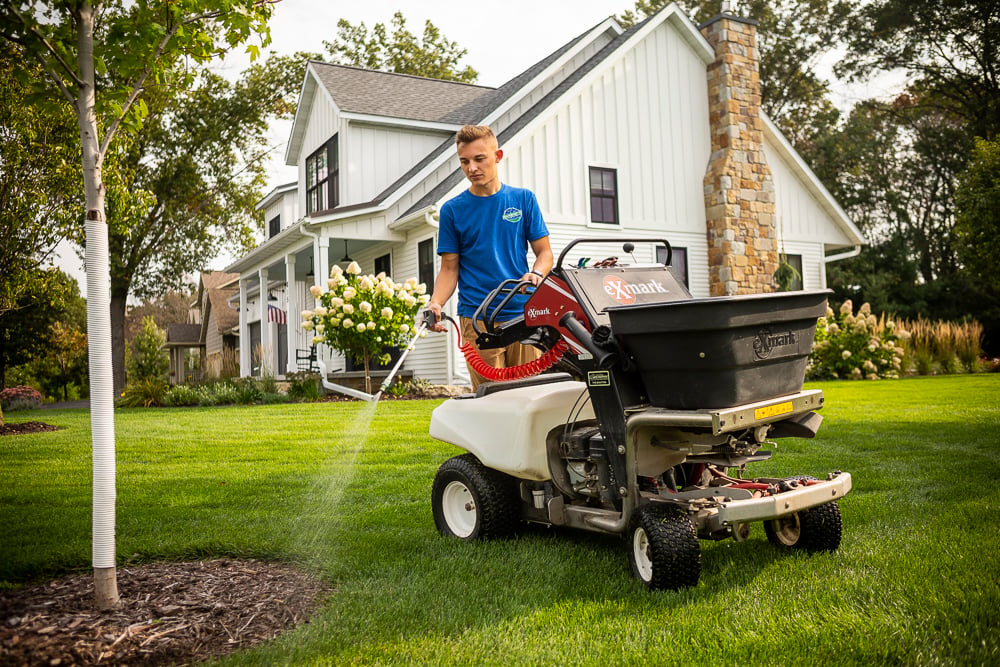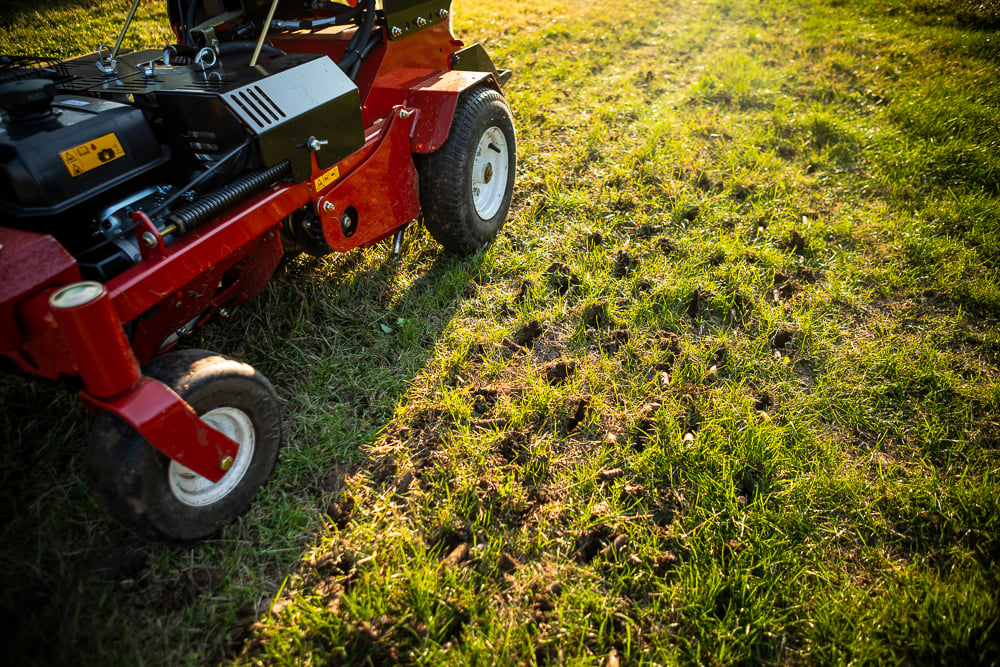Some things are great anytime, like chocolate chip cookies, vacations, and winning the lottery.
Preventing crabgrass is not on this list. There’s just a small window to keep crabgrass from taking over your lawn.
If you snooze, you lose. Then, crabgrass, the king of weeds, rules your yard.
When is it too late for crabgrass preventer? Here in Eau Claire WI, Memorial Day is too late for crabgrass preventer, as the soil is warm enough for the seeds to sprout. Ideally, you should apply crabgrass preventer for lawns from mid-March through mid-May, before the crabgrass seeds have had a chance to start growing.
Let’s learn more about crabgrass preventer timing, including:
- First, Let’s Get to Know Crabgrass
- When is the Best Time to Apply Crabgrass Preventer?
- When is It Too Late for Crabgrass Preventer?
- Can You Still Treat Crabgrass If It’s Already Growing?
- Crabgrass Preventer for Lawns: Should You Do It Yourself?
- Should You Put Crabgrass Preventer on Wet or Dry Grass?
- Do You Put Down Fertilizer or Crabgrass Preventer First?
- The Best Crabgrass Control? A Healthy Lawn
First, Let’s Get to Know Crabgrass
OK, you’d probably rather not.
But if you’re going to wage war against something, it’s smart to know your enemy, right?
Why is crabgrass so bad? It’s green. It has “grass” in its name. What’s the big deal?
Crabgrass isn’t actually grass, but an annual weed that spreads fast and can quickly take over your lawn and make it look terrible. Even worse, it can kill off other varieties of grass and steal important nutrients like nitrogen that your lawn needs.

Crabgrass thrives in hot, dry conditions and often appears in Eau Claire lawns in early summer when temperatures start to rise.
What does crabgrass look like? This warm-season annual has leaves that are wider than grass blades and it grows in clumps horizontally, close to the ground.
The stems grow outward rather than up, and look like the legs of a crab.
If crabgrass could brag about something, it would probably be this: each crabgrass plant produces as many as 150,000 seeds. You have to grudgingly admit that’s pretty impressive.
Those pesky seeds stay behind, ready to germinate the following spring and start the evil cycle all over again. Even seeds that don't germinate right away can hang around to sprout in future years.
That’s part of what makes crabgrass a real weed super villain — and really challenging to control.
Crabgrass preventer timing is everything. The real key here is pre-emergent weed control — targeting the seeds as they germinate and take root in the soil to prevent them from sprouting in the first place.
If you wait until crabgrass shows up, you’ll have a much tougher time getting rid of it.
When is the Best Time to Apply Crabgrass Preventer?
It’s crucial to apply crabgrass pre-emergent in early spring to target those weed seeds as they germinate and take root in the soil — so they don’t become more seed-producing plants.
”It all depends on soil temperature,” says Jake Jacobson, lawn care operations manager at RainMaster Lawn Systems. “Crabgrass starts to germinate when the soil temperature is at 55 degrees and above. So we need to have pre-emergent down before then.”

Here in Eau Claire, WI, that crabgrass preventer timing typically means mid-March through Memorial Day, Jacobson says.
He keeps track of the soil temperature to gauge exactly when to apply crabgrass pre-emergent. If the soil is warmer earlier than usual, due to an early spring, the pre-emergent needs to go down earlier than usual. Remember, crabgrass preventer timing is super important.
But here’s an important thing to know about crabgrass timing: crabgrass pre-emergent works for about six weeks, then it’s no longer effective. So if you apply it earlier in the season, it will stop working earlier, too, leaving your lawn vulnerable to crabgrass.
While most lawn care and weed control services in Eau Claire, WI do one crabgrass control application in the spring, “We do something a little different to get better results,” Jacobson says. RainMaster technicians do a “split application,” he says, “to really hammer the crabgrass control and prevent it from emerging.”
RainMaster Lawn Systems pros apply one round of crabgrass preventer for lawns in early spring and another in late spring. This extends protection, creating double trouble for crabgrass seeds trying to take hold, grow, and drive you crazy.
When Is It Too Late for Crabgrass Preventer?
Once Memorial Day hits, and you’re tossing hot dogs on the grill, those bountiful crabgrass seeds have already sprouted due to the warm soil. Too late for pre-emergent crabgrass control.
It’s a good weekend for a cookout, though. Too bad that crabgrass will put you in a bad mood.
Can You Still Treat Crabgrass If It’s Already Growing?
Your best bet is to attack crabgrass early, before it has a chance to sprout.
But weeds are both sneaky and tenacious, and some crabgrass might sneak through despite your best efforts.

Or maybe life got busy and you missed that all-important window for pre-emergent crabgrass control. It happens.
In that case, you turn to a post-emergent weed control strategy. Unlike pre-emergent weed control, post-emergents kill weeds once they’re already growing.
That’s why you need lawn care and weed control in Eau Claire, WI that includes both weed prevention and curative treatments from early spring to late fall. That’s your best bet to control all weeds, including crabgrass.
Crabgrass Preventer for Lawns: Should You Do It Yourself?
You’ll have no trouble finding DIY crabgrass control products
at the home and garden store. Does it work? Maybe — as long as you follow the directions exactly.
That part about following directions is really important.
Plenty of homeowners make mistakes.
If the product directions tell you to apply it more than once, you can’t just apply it once then wonder why you still have crabgrass.
If the package says it’s pre-emergent, don’t expect it to kill crabgrass that has already sprouted.
This crabgrass control thing really is an exact science. And things can go wrong.
Maybe you apply it, then it rains and washes off. Ugh. Back to the store to buy more. What a waste. Meanwhile, that weed killer washed out into the groundwater, which is bad for the environment.
Or maybe you’re using some leftover crabgrass preventer from last year. Bad news: if it was in your garage and froze over the winter, it’s no good anymore.
Speaking of garages, how are your garage organization skills? Do you really want to store this stuff?
One more thing you should know: the crabgrass control you buy at the store is a pre-diluted mix, ready to apply.
Here at RainMaster, we mix our own crabgrass preventer for lawns so we know exactly what the concentration is, and exactly how much to apply per 1,000 square feet.
Should You Put Crabgrass Preventer on Wet or Dry Grass?
Dry grass is best. After applying the preventer, lightly water the lawn to activate the product and move it into the soil so it can start working.
If you apply crabgrass preventer to grass that’s too wet, it can run off instead of sinking in.
Do You Put Down Fertilizer or Crabgrass Preventer First?
Focus on the crabgrass preventer first, before applying fertilizer. You don’t want to encourage new grass growth then apply crabgrass control that could kill it.
Follow up with fertilizer when your lawn is actively growing.
The Best Crabgrass Control? A Healthy Lawn
Preventing crabgrass is much easier than getting rid of it. Once it takes hold, it’s stubborn. And it leaves behind so many seeds, remember?
A thick, healthy lawn not only looks great and feels amazing on your bare feet, it’s the best way to prevent all weeds, including crabgrass.

That means staying on top of all the good lawn care practices: occasional aeration to encourage strong and healthy roots; regular and timely fertilizer; proper irrigation.
Check out a couple key tips for lawn care and weed control in Eau Claire, WI:
Mow Tall
We know, it’s tempting to mow even lower than usual to mow down those annoying weeds. Take that, crabgrass!But it doesn’t work that way.
Taller grass helps a lawn grow thicker. Mow too short, and the soil heats up, helping those pesky weed seeds to germinate.
Shorter grass also has a weaker root system, which makes it more susceptible to weeds like crabgrass
Proper Watering
A lawn that’s too wet or too dry encourages weeds like crabgrass. Consider investing in a professionally installed irrigation system to help water your lawn correctly and efficiently. Then, make sure it continues to work efficiently with regular irrigation system inspections.
Aerate Your Lawn
Lawn aeration pulls out little plugs of soil, creating spaces so that air and water can penetrate, which leads to healthier roots. Healthier roots make for a healthier, thicker lawn, better able to resist not just weeds like crabgrass, but damaging pests and diseases, too.

It also helps your lawn better tolerate summer’s heat and drought.
If Your Lawn Looks Healthy, Can’t You Skip Crabgrass Preventer?
Nope. Nice try, though. Remember, those tenacious crabgrass seeds are hanging out, sometimes for years. Ignore them, and they’ll turn into ugly weeds. You really need to take preventive action with this weed villain.
Get Expert Crabgrass Preventer Timing with RainMaster
Chances are, you’ve got a lot on your plate, a jam-packed calendar, and you really don’t need another important deadline like crabgrass preventer timing to keep track of right?
Or maybe your big frustration is a garage full of half-used containers of DIY crabgrass killer that never worked.
New plan: leave your crabgrass to us, for expert, experienced lawn care & weed control in Eau Claire, WI.
Let’s create a custom nutrition plan for your lawn, so the roots will be nourished, the soil packed with nutrients, and your grass so thick and healthy, crabgrass will have a tough fight ahead — especially after the one-two punch of two rounds of pre-emergent crabgrass killer we’ll apply at exactly the right time.
Are you ready to stop battling that frustrating crabgrass? Request a quote today! We’ll review your options together so you can make a great choice. Then, you can finally enjoy your lawn and stop worrying about it.


